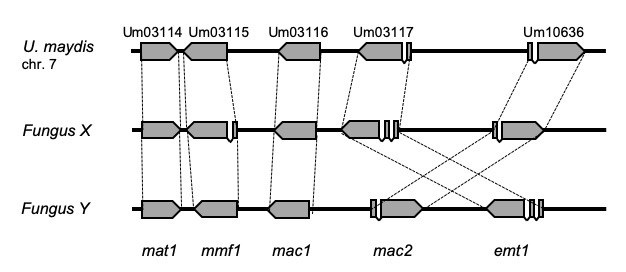Main Content
Glycolipids in Ustilago maydis

The corn smut fungus Ustilago maydis produces two classes of glycolipids under nitrogen-limiting conditions: the mannosylerythritol lipids (MELs) and the cellulose lipids, also known as ustilagic acids (UA). The production of both classes is governed by specific gene clusters (Hewald et al., 2006; Teichmann et al., 2007).
In many fungi, MELs are synthesized by a gene cluster comprising five genes (Fig. 1). The enzymatic functions of the glycosyltransferase Emt1, the acetyltransferase Mat1, and the two acyltransferases Mac1 and Mac2 have been elucidated. The transport protein Mmf1 is essential for the export of monoacetylated MELs; non-acetylated and diacetylated MEL variants can also be detected in the medium without Mmf1.
MEL synthesis begins with the condensation of erythritol and mannose by Emt1. The disaccharide erythritol-mannose is then acylated at the C2 and C3 positions of mannose by Mac1 and Mac2. This process occurs in the peroxisomes, allowing a wide range of combinations through the incorporation of fatty acid chains of varying lengths generated during β-oxidation (Freitag et al., 2014). Furthermore, this compartmentalization also enables spatial separation of the two glycolipid synthesis pathways for UAs and MELs. Finally, acetylation by Mat1 occurs at C4 and/or C6.

MELs produced by U. maydis are therefore a complex mixture of di-, mono-, and non-acetylated variants (MEL-A, -B/C, and -D), which can contain different combinations of acyl side chains. Mac1 (R1) primarily incorporates short fatty acids with chain lengths of C2, C4, and C6, while Mac2 (R2) uses C12, C14, and C16 fatty acids as substrates. In addition, the long fatty acids can be saturated, monounsaturated, and/or hydroxylated (Fig. 2).

MELs are surface-active compounds with a broad range of applications in pharmaceuticals or detergents. Depending on their acetylation pattern, MELs are capable of reducing the surface tension of liquids, emulsifying oil-containing solutions, or penetrating cell membranes.
Our research focuses on producing tailor-made MELs using a molecular toolbox. For this purpose, acyltransferases from various MEL-producing fungi of the genera Ustilago, Sporisorium, Pseudozyma, and Moesziomyces are first employed, and their properties are characterized based on the MELs they produce. The goal is, on one hand, to reduce the complexity of MEL mixtures, and on the other hand, to assign specific side-chain combinations to the various properties of MELs or to discover new properties (Fig. 3).
Another research project concerns MELs from other fungi, e.g., Sporisorium reilianum or Sporisorium exsertum, and the proteins involved in their biosynthesis. For S. reilianum, we were able to show for the first time that two genes of the MEL cluster are not expressed, while the corresponding genes of a related synthetic cluster are active. Whether this new gene cluster, which contains homologous genes for Mat2 and Mac3, also plays a role in S. exsertum is currently under investigation.
Relevant Publications:
Tiefenbacher J, Linne U, Freitag J, Sandrock B (2025) Two gene clusters are required for mannosylerythritol lipid biosynthesis in Sporisorium reilianum. mBio 0:e00899-25.
Becker F, Linne U, Xie X, Hemer A, Bölker M, Freitag J, Sandrock B (2022) Import and export of mannosylerythritol lipids by Ustilago maydis. mBio 13, e02123-22.
Becker F, Stehlik T, Linne U, Bölker M, Freitag J, Sandrock B (2021) Engineering Ustilago maydis for production of tailor-made mannosylerythritol lipids. Metab Eng Commun 12: e00165.
Deinzer H, Linne U, Xiulan X, Bölker M, Sandrock B (2019) Elucidation of substrate specificities of decorating enzymes involved in mannosylerythritol lipid production by cross-species complementation. Fungal Genetics and Biology, DOI: 10.1016/j.fgb.2019.05.003
Freitag J, Ast J, Linne U, Stehlik T, Martorana D, Bölker M, Sandrock B (2014) Peroxisomes contribute to biosynthesis of extracellular glycolipids in fungi. Mol Microbiol 93: 24–36.
Teichmann B, Linne U, Marahiel MA, Bölker M (2007) A biosynthetic gene cluster for a secreted cellobiose lipid with antifungal activity from Ustilago maydis. Mol Microbiol 66: 525–533.
Hewald S, Linne U, Scherer M, Marahiel MA, Kämper J, Bölker M (2006) Identification of a gene cluster for biosynthesis of mannosylerythritol lipids in the basidiomycetous fungus Ustilago maydis. Appl Environ Microbiol 72: 5469–5477.